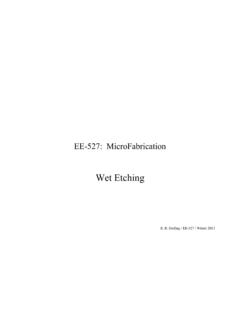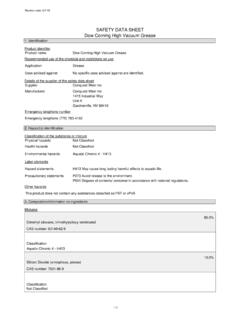Transcription of Photolithography - University of Washington
1 R. B. Darling / EE-527 / Winter 2013EE-527: MicroFabricationPhotolithographyR. B. Darling / EE-527 / Winter 2013 Photolithography Photo-litho-graphy: latin: light-stone-writing Photolithography is an optical means for transferring patterns onto a substrate. It is essentially the same process that is used in lithographic printing. Patterns are first transferred to an imagable photoresist layer. Photoresist is a liquid film that can be spread out onto a substrate, exposed with a desired pattern, and developed into a selectively placed layer for subsequent processing.
2 Photolithography is a binary pattern transfer process: there is no gray-scale, no color, and no depth to the image. R. B. Darling / EE-527 / Winter 2013 Key Historical Events in Photolithography 1826- Joseph Nicephore Niepce, in Chalon, France, takes the first photograph using bitumen of Judea on a pewter plate, developed using oil of lavender and mineral spirits. 1843- William Henry Fox Talbot, in England, develops dichromated gelatin, patented in Britain in 1852. 1935- Louis Minsk of Eastman Kodak developed the first synthetic photopolymer, poly(vinyl cinnamate), the basis of the first negative photoresists.
3 1940- Otto Suess of Kalle Div. of Hoechst AG, developed the first diazoquinone-based positive photoresist. 1954- Louis Plambeck, Jr., of Du Pont, develops the Dycryl polymeric letterpress plate. R. B. Darling / EE-527 / Winter 2013 Overview of the Photolithography Process Surface preparation Coating (spin casting) Pre-bake (soft bake) Alignment Exposure Development Post-bake (hard bake) Processing using the photoresist as a masking film Stripping Post processing cleaning (ashing)R. B. Darling / EE-527 / Winter 2013 Surface Preparation: Wafer Cleaning Typical contaminants that must be removed prior to photoresist coating.
4 Dust from scribing or cleaving (minimized by laser scribing) atmospheric dust (minimized by good clean room practice) abrasive particles (from lapping or CMP) lint from wipers (minimized by using lint-free wipers) photoresist residue from previous Photolithography (minimized by performing oxygen plasma ashing) bacteria, carbon, organics (minimized by good DI water system) water spots (minimized by good SRD practice) water itself! (minimized by a wafer singe step)R. B. Darling / EE-527 / Winter 2013 Surface Preparation: Wafer Priming Adhesion promoters are used to assist resist coating.
5 Resist adhesion factors: moisture content on surface VERY IMPORTANT! wetting characteristics of resist type of primer delay in exposure and prebake resist chemistry surface smoothness stress from coating process surface contamination Ideally, the wafer surface should be dehydrated of all H2O Wafers are given a singe step to desorb any water surface film 15 minutes in 80-90 C convection oven, OR 1 minute on 90 C hot plateR. B. Darling / EE-527 / Winter 2013 Wafer Primers For silicon and sapphire: primers form bonds with surface and produce a polar (electrostatic) surface most are based upon siloxane linkages (Si-O-Si) 1,1,1,3,3,3-hexamethyldisilazane (HMDS), (CH3)3 SiNHSi(CH3)3 trichlorophenylsilane (TCPS), C6H5 SiCl3 bistrimethylsilylacetamide (BSA), (CH3)3 SiNCH3 COSi(CH3)3 For gallium arsenide and indium phosphide.
6 GaAs already has a polar surface monazoline C trichlorobenzene, C6H3Cl3 xylene, C6H4(CH3)2 Note that most of these compounds have high toxicity. Low TLVs, so always use them under a fume hood!R. B. Darling / EE-527 / Winter 2013 Photoresist Spin Coating Wafer is held on a spinner chuck by vacuum and the resist is spread out to a uniform thickness by spin coating. Typically 2000-6000 rpm for 15-30 seconds. Resist thickness is set by: primarily resist viscosity secondarily spinner rotational speed Resist thickness is given by t = kp2/ 1/2, where k = spinner constant, typically 80-100 p = resist solids content in percent = spinner rotational speed in rpm/1000 Most resist thicknesses are 1-2 m for commercial Si processes.
7 R. B. Darling / EE-527 / Winter 2013AZ-1500 Series Photoresist Thickness Versus Spin SpeedNote that choosing the proper photoresist viscosity is the primary means to control the applied thickness. The spin speed only adds fine adjustment within this range. Graph from AZ Electronic Materials data sheetR. B. Darling / EE-527 / Winter 2013 Photoresist Spin Coatingvacuum chuckresist dispenserwafer to be coatedexcess resist flies off during rotationtimespeedslowcoatlevel outspindownphotoresistR. B. Darling / EE-527 / Winter 2013 Prototype Spin Coating Recipe This is a good starting point for most positive photoresists.
8 Automatic systems dispense the resist during the slow coat stage. The final spin speed ( 3000 rpm) sets the final resist thickness. 3000200010000speed, rpmtime, sec0 102030405060708090100 rpm500 rpm3000 rpmFinal SpeedStageRamp TimeHold Time100 rpmSlow Coat10 sec10 sec500 rpmSpin Down10 sec10 sec3000 rpmLevel Out10 sec20 sec0 rpmRamp Down20 sec0 secR. B. Darling / EE-527 / Winter 2013 Stages of Resist Coating1. EQUILIBRIUM STAGE(stopped)2. WAVE-FORMATION STAGE(~ 2 revolutions)3. CORONA STAGE(~ 30 revolutions)4. SPIRAL STAGE(~ 1000 revolutions)Edge BeadR.
9 B. Darling / EE-527 / Winter 2013 Spinning Artifacts Striations ~ 30 nm variations in resist thickness due to nonuniform drying of solvent during spin coating ~ 80-100 m periodicity, radially out from center of wafer Edge bead a residual ridge in the resist at edge of wafer can be up to 20-30 times the nominal thickness of the resist radius on wafer edge greatly reduces the edge bead height non-circular wafers greatly increase the edge bead height edge bead removers are solvents that are spun on after resist coating and which partially dissolve away the edge bead Streaks radial patterns caused by hard particles whose diameter are greater than the resist thicknessR.
10 B. Darling / EE-527 / Winter 2013 Prebake (Soft Bake) - 1 Used to evaporate the coating solvent and to densify the resist after spin coating. Typical thermal cycles: 90-100 C for 20 min. in a convection oven 75-85 C for 45 sec. on a hot plate Commercially, microwave heating or IR lamps are also used in production lines. Hot plating the resist is usually faster, more controllable, and does not trap the solvent like convection oven baking. waferphotoresisthot plate chuckcoating solventis driven offR. B. Darling / EE-527 / Winter 2013 Prebake (Soft Bake) - 2 A narrow time-temperature window is needed to achieve proper linewidth control.




